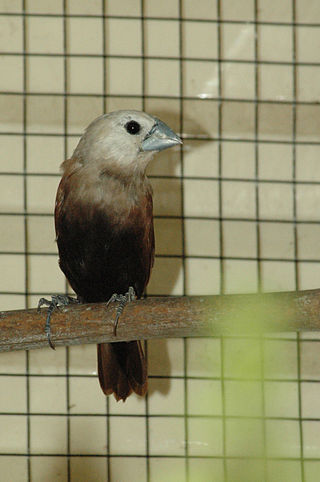
Bachman's warbler is an extinct passerine migratory bird. This warbler was a migrant, breeding in swampy blackberry and cane thickets of the Southeastern and Midwestern United States and wintering in Cuba. There are some reports of the bird from the twenty-first century, but none are widely accepted. Some authorities accept a Louisiana sighting in August 1988 as confirmed, but the last uncontroversial sightings date to the 1960s.

The common whitethroat or greater whitethroat is a common and widespread typical warbler which breeds throughout Europe and across much of temperate western Asia. This small passerine bird is strongly migratory, and winters in tropical Africa, Arabia, and Pakistan.

The Sardinian warbler is a common and widespread typical warbler from the Mediterranean region. Like most Curruca species, it has distinct male and female plumages. The adult male has a grey back, whitish underparts, black head, white throat and red eyes. Plumages are somewhat variable even in the same locality, with the intensity of a reddish hue on upper- and/or underside that varies from absent to pronounced. The female is mainly brown above and buff below, with a grey head. The Sardinian warbler's song is fast and rattling, and is very characteristic of the Mediterranean areas where this bird breeds.

The Cyprus warbler is a typical warbler which breeds only on Cyprus. This small passerine bird is a short-distance migrant, and winters in Israel, Jordan and Egypt.

The common grasshopper warbler is a species of Old World warbler in the grass warbler genus Locustella. It breeds across much of temperate Europe and the western Palearctic. It is migratory, wintering in north and west Africa.

Charles Lucien Jules Laurent Bonaparte, 2nd Prince of Canino and Musignano was a French naturalist and ornithologist. Lucien and his wife had twelve children, including Cardinal Lucien Bonaparte.

Rüppell's warbler is a typical warbler of the genus Curruca. It breeds in Greece, Turkey and neighbouring islands. It is migratory, wintering in northeast Africa. This is a rare vagrant to western Europe. The name is occasionally cited as "Rueppell's warbler".

The black-and-white warbler is a species of New World warbler, and the only member of its genus, Mniotilta. It breeds in northern and eastern North America and winters in Florida, Central America, and the West Indies down to Peru. This species is a very rare vagrant to western Europe.

The hooded warbler is a New World warbler. It breeds in eastern North America across the eastern United States and into southernmost Canada (Ontario). It is migratory, wintering in Central America and the West Indies. Hooded warblers are very rare vagrants to western Europe.

The cerulean warbler is a small songbird in the family Parulidae. It is a long-distance migrant, breeding in eastern North American hardwood forests. In the non-breeding season, it winters on the eastern slope of the Andes in South America, preferring subtropical forests.

The prothonotary warbler is a small songbird of the New World warbler family. It is named for its plumage which resembles the yellow robes once worn by papal clerks in the Roman Catholic Church.

The worm-eating warbler is a small New World warbler that breeds in the Eastern United States and migrates to southern Mexico, the Caribbean, and Central America for the winter.

John Kirk Townsend was an American naturalist, ornithologist and collector.

John Bachman was an American Lutheran minister, social activist and naturalist who collaborated with John James Audubon to produce Viviparous Quadrupeds of North America and whose writings, particularly Unity of the Human Race, were influential in the development of the theory of evolution. He was married to the painter Maria Martin. Several species of animals are named in his honor.

The eastern subalpine warbler is a small typical warbler which breeds in the southernmost areas of Europe. It was first described by the German naturalist Peter Simon Pallas in 1764 and given the binomial name Motacilla cantillans. The specific cantillans is Latin for "warbling" from canere, "to sing".

The red warbler is a small passerine bird of the New World warbler family Parulidae endemic to the highlands of Mexico, north of the Isthmus of Tehuantepec. It is closely related to, and forms a superspecies with, the pink-headed warbler of southern Mexico and Guatemala. There are three subspecies, found in disjunct populations, which differ in the color of their ear patch and in the brightness and tone of their body plumage. The adult is bright red, with a white or gray ear patch, depending on the subspecies; young birds are pinkish-brown, with a whitish ear patch and two pale wingbars.

The white-headed munia is a species of estrildid finch found in Teladan, Malaysia, Singapore, Thailand and Vietnam. This species is also introduced to Portugal. It is found in wetlands habitat. The status of the species is evaluated as Least Concern.

Menetries's warbler or Ménétries's warbler is a small passerine bird of Southwest Asia belonging to the genus Curruca. The name of the species commemorates Édouard Ménétries, the French zoologist who described the species in 1832. It is closely related to the Sardinian warbler of the Mediterranean basin and is similar to it in appearance.

The Cuban warblers are a genus, Teretistris, and family, Teretistridae, of birds endemic to Cuba and its surrounding cays. Until 2002 they were thought to be New World warblers, but DNA studies have shown that they are not closely related to that family. The family consists of two species, the yellow-headed warbler and the Oriente warbler. Both species are found in forest and scrub, with the yellow-headed warbler ranging in the west of the island and the Oriente warbler in the east. The Cuban warblers are 13 cm (5.1 in) long and have similar yellow and grey plumage.

Curruca is a genus of Sylviid warblers, best represented in Europe, Africa, and Asia. All of these species were formerly placed in the genus Sylvia.




















